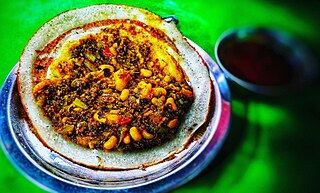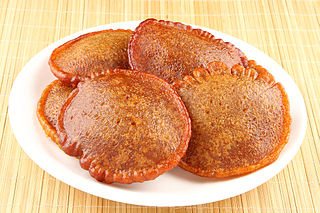
A pancake is a flat cake, often thin and round, prepared from a starch-based batter that may contain eggs, milk and butter and cooked on a hot surface such as a griddle or frying pan, often frying with oil or butter. It is a type of batter bread. Archaeological evidence suggests that pancakes were probably eaten in prehistoric societies.

A fried egg is a cooked dish made from one or more eggs which are removed from their shells and placed into a frying pan and fried. They are traditionally eaten for breakfast in many countries but may also be served at other times of the day.

Sium sisarum, commonly known as skirret, is a perennial plant of the family Apiaceae sometimes grown as a root vegetable. The English name skirret is derived from the Middle English 'skirwhit' or 'skirwort', meaning 'white root'. In Scotland it is known as crummock. Its Danish name sukkerrod, Dutch name suikerwortel and German name "Zuckerwurzel" translate as 'sugar root'.

A fritter is a portion of meat, seafood, fruit, vegetables or other ingredients which have been battered or breaded, or just a portion of dough without further ingredients, that is deep-fried. Fritters are prepared in both sweet and savory varieties.

An uttapam is a type of dosa from South India. Unlike a typical dosa, which is crisp and crepe-like, an uttapam is thicker, with toppings. The name is derived from the Tamil words appam and utthia or uttria, meaning "poured appam", because appam is cooked in a round-bottom pan, whereas utthia-appam is cooked on a flat skillet. Tamil ancient literature mentions it by name. The classic breakfast of Tamil residents consists of idli, dosas or uttappams mostly accompanied by sambar and chutney.

Indian breads are a wide variety of flatbreads and crêpes which are an integral part of Indian cuisine. Their variation reflects the diversity of Indian culture and food habits.

Lahoh[lɑħɔħ]), is a spongy, flat pancake-like bread that originated from Somalia. It is a type of flat bread eaten regularly in Somalia, Somaliland, Djibouti, Ethiopia and Yemen. Yemenite Jewish immigrants popularized the dish in Israel. It is called Laxoox/Lahoh or Canjeero/Canjeelo in Somaliland, Somalia and Djibouti, and called Lahoh/Lahuh in Yemen, respectively.

Chatānmari is a Nepalese rice crepe, which is a part of Newa cuisine of the Kathmandu Valley in Nepal. It is generally eaten during festivals and other special occasions.

Pithas are a variety of food similar to pancakes, dumplings or fritters, originating from the Indian subcontinent, common in Bangladesh and India. Pitha can be sweet or savoury, and usually made from a dough or batter, which is then steamed, fried or griddled. Very few varieties are oven-baked or boiled, and most are unleavened and cooked on a stovetop. Some versions may have a filling, garnish, or sauce. Few may be set or shaped after cooking. They are typically eaten as a snack with chai, or as treats during special occasions.

Bhojpuri cuisine is a style of food preparation common amongst the Bhojpuri people of Bihar and eastern Uttar Pradesh. Bhojpuri foods are mostly mild and are less hot in terms of spices used, but could be hotter and spicier according to individual preference.

Pohaa, also known as pauwa, sira, chira, aval (அவல்) or avalakki, among many other names, is flattened rice originating from the Indian subcontinent. Rice is parboiled before flattening so that it can be consumed with very little to no cooking. These flakes of rice swell when added to liquid, whether hot or cold, as they absorb water, milk or any other liquids. The thickness of the flakes varies from almost translucently thin to nearly four times thinner than a normal rice grain.

Neyyappam is a sweet rice-based fritter fried in ghee. Neyyappam has its origins in the southern Indian state of Kerala and coastal Karnataka. The name is derived from the words neyy meaning "ghee" and appam meaning "pancake".

Nigerian cuisine consists of dishes or food items from the hundreds of ethnic groups that comprise Nigeria. Like other West African cuisines, it uses spices and herbs with palm or groundnut oil to create deeply flavored sauces and soups.
Jolpan, or snacks, are often served at breakfast in the cuisine of Assam, although they may also be served at Bihu festivals or weddings. The word jolpan includes all the preparations namely jolpan, pitha, laru and tea. Other common items served for breakfast may include roti, luchi, ghugni and sometimes paratha etc. Jolpan are also found in Bengal. The word literally derives from "water and betel leaf" but can mean any snack.

Arisa pitha is a traditional sweet pancake from India. The crispy outer layer surrounds soft insides. It is also known by the name 'Hilsa' in Bihar, Jharkhand and Uttar Pradesh. It is the traditional sweet in Coastal Andhra of Andhra Pradesh as well where it is known as 'Ariselu'.

Telugu cuisine is a cuisine of South India native to the Telugu people from the states of Andhra, Telangana, and Yanam. Generally known for its tangy, hot, and spicy taste, the cuisine is as diverse as the people and regions in which it is consumed.

Malaysian Indian cuisine, or the cooking of the ethnic Indian communities in Malaysia, consists of adaptations of authentic dishes from India, as well as original creations inspired by the diverse food culture of Malaysia. Because the vast majority of Malaysia's Indian community are of South Indian descent, and are mostly ethnic Tamils who are descendants of immigrants from a historical region which consists of the modern Indian state of Tamil Nadu and Sri Lanka's Northern Province, much of Malaysian Indian cuisine is predominantly South Indian inspired in character and taste. A typical Malaysian Indian dish is likely to be redolent with curry leaves, whole and powdered spice, and contains fresh coconut in various forms. Ghee is still widely used for cooking, although vegetable oils and refined palm oils are now commonplace in home kitchens. Before a meal it is customary to wash hands as cutlery is often not used while eating, with the exception of a serving spoon for each respective dish.

Swabian cuisine is native to Swabia, a region in southwestern Germany comprising great parts of Württemberg and the Bavarian part of Swabia, as well as the Allgäu which has parts lying in Austria. Swabian cuisine has a reputation for being rustic, but rich and hearty. Fresh egg pastas, soups, and sausages are among Swabia's best-known types of dishes, and Swabian cuisine tends to require broths or sauces; dishes are rarely "dry".















